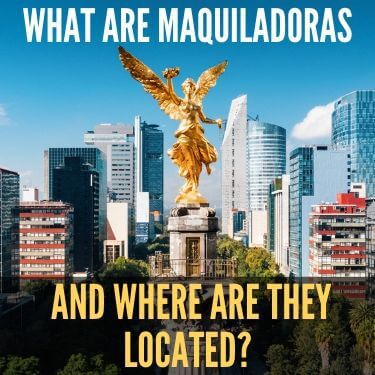
Por
 Copiar URL al Portapapeles
Copiar URL al Portapapeles
What are maquiladoras? If you run any business that sells manufactured products, you’ve probably heard about this term and how it can be useful to you. Also known as maquilas, these assembly plants are a great asset to companies located in a country outside of Mexico. They provide many business incentives that the company could not utilize in their own native country. There are thousands of maquiladoras that can produce goods for various industries such as clothing, cars, and consumer electronics.
What are Maquiladoras? A maquiladora is a factory run by a foreign company, that is given tax advantages and is typically located near the border between the United States and Mexico. Maquiladoras are a result of NAFTA and the IMMEX program.
Table of Contents

The history of the maquiladora first started in 1964 after the Bracero Program ended. The Bracero Program allowed Mexican agricultural workers into the United States seasonally, and Mexico faced a large unemployment issue when the program stopped. With so many unemployed, Mexico needed to attract foreign investment in order to prevent economic collapse. The Mexican government created the Border Industrialization Program in 1965, now the IMMEX Program, to help.
Maquiladoras’ inexpensive labor and their ability to be 100% foreign-owned operations caused a huge growth in the factories, which was exacerbated when the North American Free Trade Agreement (NAFTA) was passed in 1994. The number of maquiladora plants exploded once NAFTA was ratified, and they became the most desired option for running a manufacturing operation in Mexico.
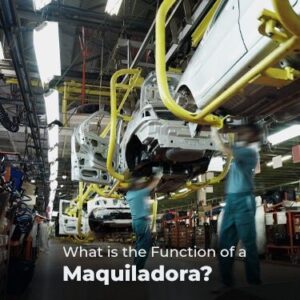
Maquiladoras are often used to describe this specific type of manufacturing operation, but in Mexico, the term simply means “assembly plant.” The function of the assembly plant is to provide inexpensive labor to a manufacturing operation while simultaneously giving the business operation certain tax advantages. The factory is able to import raw materials for manufacturing that are duty-free or tariff-free and then export the finished products back to the country and the business that produces the goods.
The most common countries that utilize maquiladoras are the United States or Canada. The foreign company manages the long-term business strategy and provides manufacturing knowledge to Mexico, but Mexican-based management is responsible for day-to-day operations.
Companies should consider using a maquiladora if they want to lower their operational expenses and produce goods without being subjected to high labor costs, duties or tariffs. Combining these factors leads to an increase in profitability while increasing their presence in the global market.
Some of the main advantages when using maquiladora manufacturing are a decreased cost in the workforce, having a foreign headquarters, and capitalizing on free trade agreements. Moreover, there are numerous incentives to create and use a maquiladora. Using the United States as an example, a maquiladora provides an advantage in the following ways:
Foreign countries benefit from maquiladoras but what does Mexico receive in return? The factories strengthen Mexico internally by:
The maquiladora industry and export sector has grown rapidly, creating over 900,000 jobs. The unemployment rate has significantly dropped amongst border cities and goods from the factories now account for 50% of all exports from Mexico. The Maquiladora Program has ensured that Mexico's manufacturing will continue to be an important part of the world market economy for the foreseeable future.
The process of establishing and using a maquiladora can appear both complex and daunting to a foreign company. However, it can also be extremely beneficial to the company’s profits, production, and overall advantage within their market.
Maquiladoras are located on the U.S.-Mexico national border in order to improve supply chain management. Close geographic proximity minimizes transportation costs and time spent transporting materials and goods. The factories are highly concentrated among the U.S.-Mexico border states of:
Baja California and Chihuahua make up most of the maquiladoras in the 6 border states. In addition to that, however, maquiladoras can be found throughout Mexico and many are located in Ciudad Juarez and Tijuana. It is common for some cities in Mexico to be paired with a U.S. city that is close in distance. Some of those U.S.-Mexico city pairs are:
Most of these locations are within 20-30 minutes of each other with Sierra Vista-Douglas, Arizona to Agua Prieta taking the most time at over 90 minutes. Matamoros, Nuevo Laredo, and Reynosa are other major maquiladora locations, all of which are located in the Mexican border-state Tamaulipas. Many maquiladoras are also strategically located by airports, roads, railroads and shipping ports.
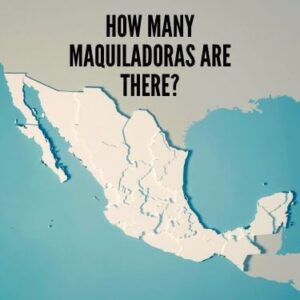
As of 2019, there are over 3,000 maquiladora factories in northern Mexico. This number has increased over the last 20 years, from 2,000 factories in the year 2000. Nearly 90% of maquiladoras are in the border zone between the U.S. and Mexico.
There are more than one million Mexicans working in the 3,000+ maquiladora plants. The maquiladora industry as a whole employs over 1,130,000 people. Employment in the maquila industry has been growing steadily, and over 15% of Mexico’s manufacturing jobs are from maquiladoras.
Manufacturing jobs pay wages are 40% higher in the export-oriented field as opposed to the rest of the manufacturing industry. The majority of maquiladora employment takes place in Mexico’s border states.

Traditionally, maquiladoras were utilized mostly in the textile sector, to make products like fabrics, clothing, shoes, and bedding. However, the variety of products that are assembled in maquiladoras has increased dramatically since NAFTA was ratified. Now, everything from the consumer electronics industry to the aerospace industry utilizes maquilas to mass-produce products for U.S. markets.
U.S. companies manufacture countless different kinds of products in Mexico. Take a look at just a small example of the types of products that get assembled in maquilas:
Even if you don’t see a product on that list that resembles what you sell, you can still take advantage of the opportunity. Almost any industry that mass produces manufactured goods could benefit from shifting their manufacturing to Mexico.
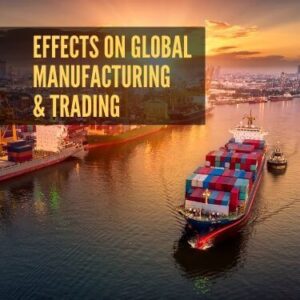
Ever since the IMMEX program was launched in 1965, Mexico’s manufacturing sector has seen tremendous growth. With companies now turning away from the growing costs of labor in China and turning to Mexico for manufacturing, this expansion of the maquila program shows no signs of slowing down.
Trade between the U.S. and Mexico is particularly strong, as a result of NAFTA. With the constant flow of goods moving through the border in both directions, the trade relationship between the two countries has never been better. This positive relationship and consistent trade have revived the otherwise doomed Mexican economy.
In addition to that, maquiladoras are not just owned by U.S. companies now, either. Corporations all over the world, from Canada to South Korea, are investing in the manufacturing opportunities in Mexico. As a result, more than 1.5 million jobs have been created in Mexico, and the formerly unsophisticated program has evolved into a worldwide manufacturing resource. Mexico is now a player in the global market, after having signed free trade agreements with 32 different countries over the last 30 years.
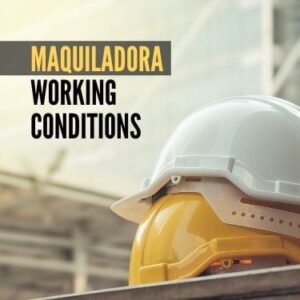
Over the years, maquiladoras have built up a bad reputation, especially since the creation of NAFTA vastly expanded the network of locations serving as these assembly plants. News spread like wildfire about child labor, workplace accidents, and slave-like conditions in these Mexican “sweatshops.” However, although these conditions were serious and very real for some places, they are not the reality for most maquiladoras.
Most maquiladoras are decent places to work, with air conditioning and clean workspaces, but there are some things to look out for. When looking for a place in Mexico to source manufacturing for your company, you should always have someone tour the facility first-hand, or go personally to inspect the conditions before settling on a decision. Not only do you need to protect your company from liability, but you should be careful about not supporting corrupt organizations.
Some of the biggest problems with maquiladoras stem from their biggest benefit. The point of outsourcing manufacturing to Mexico is to reduce costs, but some facilities try to save even more money by putting off crucial maintenance.
Many of these assembly plants have large, dangerous machinery. Failure to properly maintain that machinery could put lives at risk, so you should ensure that the maquiladora you work with takes care to maintain the facility. Even little things, like keeping the facility clean and ensuring the lights stay on can be a problem with shady management.
In addition to the facility itself, you should also focus on the employees. Even properly functioning equipment can be dangerous if operated by an inexperienced worker. During your visit, make sure to question the training process, and ensure that all employees working with machines know how to operate them safely.
Manufacturing electronics, cosmetics, medical devices, and many other commodities can often expose workers to chemicals and other hazards. Just like with machines, dangerous chemicals should only be handled by individuals trained to do so. You should insist that safety protocols are in place and appropriately communicated to all workers so that disasters can be prevented at all costs. If need be, you should personally ensure that the workers are being properly informed on safety procedures.
Despite their reputation, there are maquiladoras with good working conditions out there. The media has given extensive coverage to the exceptions, and that has given them all a bad name. However, if you take the time to investigate the facility and the way it is managed, you can ensure that all the workers are paid well, and kept happy and safe.

There’s a lot more to IMMEX than meets the eye. At a basic level, the IMMEX program can be explained as a federal authorization to temporarily import raw materials, components, and other parts to be assembled in Mexico and subsequently re-exported to the U.S. Other things may also be eligible for this temporary import, such as the machines used in the manufacturing process, and even managers to monitor the maquila processes and employees.
There are five different categories in the IMMEX program, which are referred to as “modalities.” These modalities offer different authorizations to companies depending on which one they choose. A company can only select one modality, so make sure you understand how each option aligns with your individual needs.
These five modalities are:
A controller company is a bit different from what you might expect from a maquiladora. One company is certified by the Mexican government, out of a group of other companies located in Mexico. What this means is that the certified company will be granted the right to control and oversee operations for the other companies in the group.
The controller company gets the responsibility of managing the imports and exports of all the companies in its group. Any imported products and materials can be freely moved between, and stored within, any of the different companies. Each company remains its own individual entity and maintains its unique tax ID, but they become units in a larger operational process.
In order for a company to become a certified controller company, it needs to submit a number of different documents, like:
These documents must be presented to the Ministry of Finance and Public Credit. After that, if it is deemed appropriate, the controller company will be officialized with a certificate.
The industrial modality is the most commonly utilized IMMEX category, and it is the one that has become representative of the maquiladora industry as a whole. A company utilizing the industrial modality of the IMMEX program ships raw materials and components into Mexico to be assembled in maquilas. Once the product has been assembled, it is then shipped back into the U.S. to be sold.
Companies that utilize the IMMEX services modality are able to handle the finished products after they have been assembled. Service companies are able to store and distribute both raw materials and finished products on behalf of industrial companies.
Finished products can stay in the service warehouse for six months until they are exported back into the U.S., but extensions are available. Raw materials and unused components may remain in Mexico for up to a year before being assembled, but extensions are also available in this situation.
In order to take direct advantage of the IMMEX program, interested companies would need to have a location in Mexico to do business, and that’s not always possible for every company. That’s where the Shelter program comes in handy. If your company has no presence in Mexico, but you still want to use a maquiladora for your manufacturing, then you will need to utilize a “shelter” owned by another company.
The shelter program is relatively simple. A company in Mexico can choose to register for the shelter modality of the IMMEX program. This allows them to offer IMMEX services to foreign companies that don’t have a Mexican presence. This includes manufacturing, storage, and distribution services.
Shelter companies would be liable for all compliance with permits, labor, and customs laws, which reduces the risk for you. Most times, these companies also work to guide you through the process of running a maquiladora and can offer management services to make the entire ordeal much simpler. However, Shelter companies do not manage the actual manufacturing of the products. That would remain your responsibility.
Companies that are certified under the IMMEX program but cannot perform the manufacturing themselves, because of a lack of resources, property, machinery, or expertise, must employ the help of a third-party. Third-party companies are authorized under the IMMEX program to supply other companies with the resources and processes they lack. That could mean that you rely on a third party to warehouse your goods and materials, or you employ a third-party contractor to find employees for your maquila.
If you intend to use a third party to help run your maquiladora, you will need to submit a couple of additional documents when you apply for your certification. You will need to submit:

If you want to move your company’s manufacturing into Mexico, you have three options for getting started with a maquiladora. You could establish your own brand new maquiladora in Mexico from the ground up, you could work with a subcontractor to save you a few steps along the way, or you could operate under a shelter company and avoid a lot of the paperwork.
The most direct way of shifting manufacturing to Mexico is to establish a Mexican corporation that is directly managed by your parent company. If you want complete control over your supply chain, you should take the time to establish the maquila yourself, even though the process will be difficult. That way, you won’t have to worry about your operations being dependent on another company, and you can run it exactly how you want to.
The first thing you’re going to need to do if you want to set up your own maquiladora is to acquire the right legal paperwork. You will need to reach out to a Mexican attorney, in order to file the following documents for incorporation:
Once those documents are settled, you will need to complete what is known as an “Environmental Preventative Report.” This report is a detailed account of the activities your maquila will be responsible for, to show that your operations will not harm the environment.
The next thing you’re going to need to do is to buy or rent the land where you will set up your maquiladora. You must provide evidence of the purchase or lease, and you may also be required to apply for a land-use permit.
Then comes everyone’s favorite part: taxes. New businesses in Mexico must apply for a Federal Taxpayer Registry Number, and must submit an Advanced Electronic Signature to the Ministry of Finance and Public Credit. Then, the business will be expected to pay a monthly payroll tax, as well as a corporate federal income tax of 30%.
A formal agreement must then be drafted between your parent company and your new Mexican maquiladora. Additionally, you will need to make a Collective Labor Agreement with a local labor union every two years in order to stay compliant with Mexican labor laws. If you intend to employ more than 20 people, you may be able to use a Collective Bargaining Agreement or an Individual Employment Agreement instead.
When it is finally time to start hiring employees, it is pretty safe to assume that the vast majority of your workers are going to be locals. However, any workers that you would want to move to Mexico from another country is going to need a work visa. Here are three visa types for working in Mexico:
Finally, after setting up everything else, you’re ready to apply to the IMMEX program. In order to file a maquila application, you would need to submit documentation and details about your company, like:
Setting up a maquila from the ground up is a huge endeavor, but it is important if you want to exercise complete control over your supply chain. However, if you cannot spare the time or resources to pull this off, there are other options available to you.
Shelter companies provide an easy solution to the frustratingly complex process of shifting manufacturing to Mexico. If you choose to work with a shelter company instead of building your own maquiladora company, then you can count on them to handle all the paperwork and legal documentation on your behalf.
So... how does it work? The shelter company remains the legal owner of the company in the eyes of the Mexican government. This means that they handle the responsibility of applying for permits, conforming to laws, and managing liability for the company. They also lease or own the property, manage employees, and deal with all tax considerations.
However, even though the shelter service technically owns the operation, it is up to you to supply materials, knowledge, and equipment just like you would have to for your own maquiladora. However, shelter services are also likely to provide additional services, such as accounting, HR, and payroll management, so you only have to focus on the manufacturing aspect.
If working with a shelter service still seems like too much for you to manage, there is one other option left that removes almost all responsibility from you—but at the cost of not having any control over the process. If you don’t have the time or resources to dedicate to your manufacturing process, your last option is to go with a subcontracting company.
A subcontracting company is like a third-party company with connections to many different maquiladoras. You would establish a contract with the subcontracting company and ship your materials and equipment to them. They would then select a maquila location that would be best suited for your needs and then manufacture everything to your specifications. Subcontracting companies also tend to manage the import and export process, so all you need to do is get the materials ready for shipment.
This method is cheap and easy, but there are several reasons to be cautious with it. Namely, you could be sacrificing the quality of your product, and you don’t really know what could be going on inside the maquila.
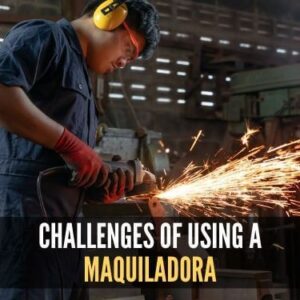
If you’re considering shifting your manufacturing to Mexico, there are a few things you should understand about the potential challenges you could face along the way. There are a number of things that could make using a maquiladora more challenging, like:
However, there are many great ways of overcoming these potential obstacles, from outsourcing recruiting and management, to working with a third-party logistics company for all your transportation needs.
R+L Global Logistics is on hand when you’re ready to transport your goods from a maquiladora to the United States. We’ve been taking care of cross border freight for over 30 years and know how to get your freight from here to there with a 99.5% on-time delivery rate and real-time freight visibility. We also provide:
No matter whether you're working with a maquiladora near the border in Contact us today for a quote on your cross border shipment and ensure that the money you saved from the maquiladora doesn’t get wasted in transit.
 Copiar URL en el Portapapeles
Copiar URL en el Portapapeles
